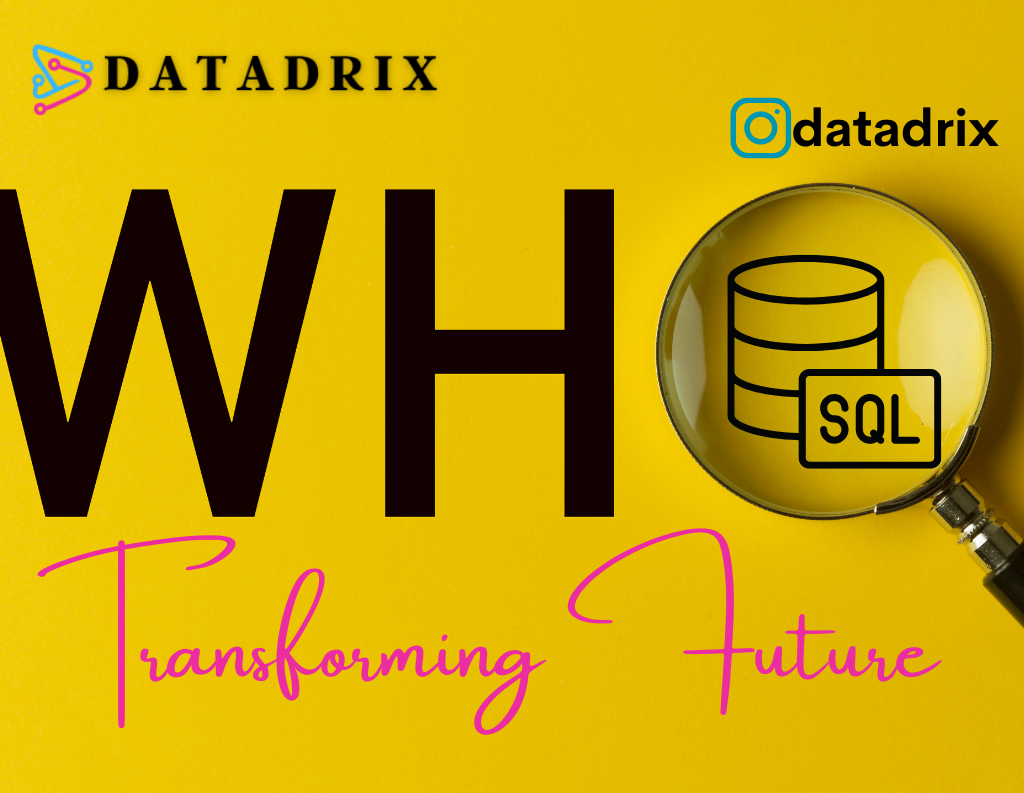
DATADRIX : MySQL Database
Managing Your Data with Precision
Our MySQL course offers an immersive learning experience in the world of relational databases. Designed to accommodate both beginners & experienced, this comprehensive program delves into the intricacies of MySQL, a fundamental database management system widely used across industries. You’ll learn to design & optimize databases, write powerful queries & ensure data integrity. With real-world projects and hands-on exercises, providing you with valuable insights and skills that are highly sought after in the job market. By the end of the course, you’ll be well-equipped to tackle database challenges, making you a proficient MySQL professional ready for exciting career opportunities in data management and analysis.
MySQL Course
A Comprehensive Course to Database Querying and Management
Unlock the power of data with our MySQL training program. MySQL is a leading open-source relational database management system that underpins countless web applications and business solutions. Our training provides a structured learning experience, equipping you with the skills to master database design, query optimization, and data management. Whether you’re a beginner or an experienced database professional, our expert instructors will guide you through a comprehensive curriculum. Gain hands-on experience working with real-world datasets, learn the intricacies of SQL, and understand the principles of efficient database design. Upon completion of our MySQL training, you’ll have the knowledge and confidence to harness the full potential of MySQL, making you an invaluable asset in the world of data-driven decision-making.
At DATADRIX, we believe in the power of practical learning. Our MySQL course is not just theory; it’s a hands-on journey. You’ll work with real-world datasets, design and optimize databases, and write SQL queries to extract meaningful insights from data. Throughout the course, you’ll also be exposed to industry best practices, ensuring that you are well-prepared for the professional world of data management. From developing secure and efficient databases to understanding data normalization and performance optimization, our MySQL course covers all aspects of database administration.
Upon successful completion of our MySQL course, you will receive a recognized certification, showcasing your proficiency to potential employers. With the ever-increasing demand for skilled database administrators and data analysts, this certification will open doors to a variety of career opportunities. Whether you aim to work as a database administrator, data analyst, or even pursue a career in database development, our course equips you with the knowledge and skills necessary to excel in a data-driven world. Join our MySQL course, and let’s embark on a journey to uncover the fascinating world of databases and data management together. Your future in the realm of data awaits!
Dive into the world of databases and data management with our MySQL course. MySQL is a powerful open-source relational database management system that underpins countless applications and websites worldwide. Our comprehensive course is designed to cater to beginners as well as individuals with some prior experience in database management. With the guidance of our expert instructors, you will explore the fundamentals of MySQL, learn to design and maintain databases, and master the art of crafting efficient SQL queries. Whether you aim to kickstart a career in database administration or enhance your existing skills, our MySQL course offers a structured and hands-on learning experience to help you succeed.
In-Demand Skill: Our MySQL course offers essential skills for database management and querying, a proficiency highly sought after in the IT and data-driven industries.
Beginner-Friendly: Our MySQL course is beginner-friendly, meaning it is designed with newcomers to database management in mind. We start with the basics, ensuring that even those with no prior experience in databases can grasp the fundamentals
Versatility: You’ll acquire skills that are not only highly sought after but also applicable in a wide range of fields. Whether you’re interested in web development, data analysis, e-commerce, or any industry requiring data storage and retrieval, MySQL proficiency is a valuable asset.
Structured Learning: Our MySQL course offers structured learning to equip you with the essential skills for managing and querying databases effectively. You’ll follow a carefully designed curriculum that covers the fundamentals of relational databases, SQL, and advanced database management.
Hands-On Practice: Our MySQL course focuses on hands-on practice, ensuring that you actively engage with the database management system. You’ll have the opportunity to apply your learning in a real-world context, working with databases, writing SQL queries, and managing data.
Customized Learning Paths: You’ll receive instruction and assignments that align with your current skill level, making the learning experience efficient and highly relevant to your individual goals.
Experienced Instructors: They bring a wealth of industry knowledge and practical expertise to the classroom, ensuring that you receive the most valuable insights and real-world insights. With their guidance, you’ll delve into complex database concepts, optimization strategies, and advanced data management techniques, equipping you with the skills to excel as a database expert.
Career Advancement: A MySQL course offers an excellent opportunity for career advancement. In this program, you’ll acquire comprehensive skills in managing and optimizing databases, a critical competency in various industries.
Job Placement Support: Our extensive network and industry partnerships enable us to guide you towards promising career paths, helping you secure a position where you can put your newly acquired MySQL skills to practical use.
Community and Networking: Students not only learn the intricacies of MySQL but also connect with fellow learners, industry experts, and professionals. This networking aspect fosters collaboration, idea sharing, and a supportive community where knowledge and experiences are exchanged, making the learning journey even more enriching.
Certification: This course covers a wide range of topics, including database design, SQL query optimization, data manipulation, and database administration. By completing this course and earning the certification, participants will demonstrate their proficiency in handling databases efficiently, a valuable skill in various career opportunities related to data management and software development.
Continuous Learning: Python is an ever-evolving language. Our training institute emphasizes continuous learning, ensuring that you stay updated with the latest trends and advancements in the Python ecosystem.
Ongoing Support: Even after completing the training, you’ll have access to resources and support, ensuring you stay up-to-date with the latest developments in MySQL and database management.
Embarking on a MySQL training journey at DATADRIX is an investment in your future, whether you’re just starting your career or looking to further develop your skills. We welcome both fresher and experienced students to join us and explore the exciting world of IT Technologies.

Course Syllabus :
A syllabus is a meticulously crafted document that serves as a comprehensive roadmap for the training program. It plays a pivotal role in guiding candidate along their learning journey, offering a structured framework for acquiring knowledge and honing skills.
A well-designed syllabus offers a bird’s-eye view of the course’s content, complete with a meticulous breakdown of modules or units, well-crafted lesson plans, and a timeline for completion. It doesn’t merely outline what candidate will learn but also lays out the precise learning outcomes and objectives that they’re expected to master by the course’s conclusion.
Embedded within the syllabus are detailed descriptions of each topic, accompanied by a treasure trove of learning resources, suggested readings, and insights into the methods by which knowledge will be assessed. It’s not just a map, it’s a compass guiding candidate through a labyrinth of assignments, projects, exams, and a transparent grading system, making their educational journey as informed and rewarding as possible.
An Awesome Community
Our students, instructors and mentors come from different colleges, companies, and walks of life.
Meet our team and students

Joining DATADRIX means you’ll create an amazing network, make new connections,
and leverage diverse opportunities.

“Validate Your Expertise and Propel Your Career”
- Certification: A testament to your skills and knowledge, certifications demonstrate your proficiency in specific areas of expertise, giving you a competitive edge in the job market.
- Expand Opportunities: Certifications to unlock new career opportunities, gain credibility with employers, and open doors to higher-level positions.
- Continuous Growth: Certifications not only validate your current skills but also encourage continuous learning and professional development, allowing you to stay updated with the latest industry trends and advancements.
Frequently Asked Questions

Who can make career transition into Python
Add context to your column. Help visitors understand the value they can get from your products and services.

What tools will going to cover
Add context to your column. Help visitors understand the value they can get from your products and services.

What is the scope of machine Python
Add context to your column. Help visitors understand the value they can get from your products and services.

Duration and scope of python language
Add context to your column. Help visitors understand the value they can get from your products and services.
